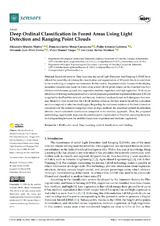Mostrar el registro sencillo del ítem
Deep Ordinal Classification in Forest Areas Using Light Detection and Ranging Point Clouds
| dc.contributor.author | Morales-Martín, Alejandro | |
| dc.contributor.author | Mesas Carrascosa, Francisco Javier | |
| dc.contributor.author | Gutiérrez, Pedro Antonio | |
| dc.contributor.author | Pérez Porras, Fernando | |
| dc.contributor.author | Vargas, Víctor Manuel | |
| dc.contributor.author | Hervás-Martínez, César | |
| dc.date.accessioned | 2024-04-03T11:13:36Z | |
| dc.date.available | 2024-04-03T11:13:36Z | |
| dc.date.issued | 2024 | |
| dc.identifier.uri | http://hdl.handle.net/10396/27801 | |
| dc.description.abstract | Recent advances in Deep Learning and aerial Light Detection And Ranging (LiDAR) have offered the possibility of refining the classification and segmentation of 3D point clouds to contribute to the monitoring of complex environments. In this context, the present study focuses on developing an ordinal classification model in forest areas where LiDAR point clouds can be classified into four distinct ordinal classes: ground, low vegetation, medium vegetation, and high vegetation. To do so, an effective soft labeling technique based on a novel proposed generalized exponential function (CE-GE) is applied to the PointNet network architecture. Statistical analyses based on Kolmogorov–Smirnov and Student’s t-test reveal that the CE-GE method achieves the best results for all the evaluation metrics compared to other methodologies. Regarding the confusion matrices of the best alternative conceived and the standard categorical cross-entropy method, the smoothed ordinal classification obtains a more consistent classification compared to the nominal approach. Thus, the proposed methodology significantly improves the point-by-point classification of PointNet, reducing the errors in distinguishing between the middle classes (low vegetation and medium vegetation). | es_ES |
| dc.format.mimetype | application/pdf | es_ES |
| dc.language.iso | eng | es_ES |
| dc.publisher | MDPI | es_ES |
| dc.rights | https://creativecommons.org/licenses/by/4.0/ | es_ES |
| dc.source | Morales-Martín, A.; Mesas-Carrascosa, F.-J.; Gutiérrez, P.A.; Pérez-Porras, F.-J.; Vargas, V.M.; Hervás-Martínez, C. Deep Ordinal Classification in Forest Areas Using Light Detection and Ranging Point Clouds. Sensors 2024, 24, 2168. | es_ES |
| dc.subject | LiDAR point cloud | es_ES |
| dc.subject | Deep Learning | es_ES |
| dc.subject | Ordinal classification | es_ES |
| dc.subject | Soft labeling | es_ES |
| dc.title | Deep Ordinal Classification in Forest Areas Using Light Detection and Ranging Point Clouds | es_ES |
| dc.type | info:eu-repo/semantics/article | es_ES |
| dc.relation.publisherversion | https://doi.org/10.3390/s24072168 | es_ES |
| dc.relation.projectID | Gobierno de España.PID2020-115454GB-C22/AEI/10.13039/501100011033 | es_ES |
| dc.relation.projectID | Gobierno de España.MCIU/FPU21/03433 | es_ES |
| dc.rights.accessRights | info:eu-repo/semantics/openAccess | es_ES |

